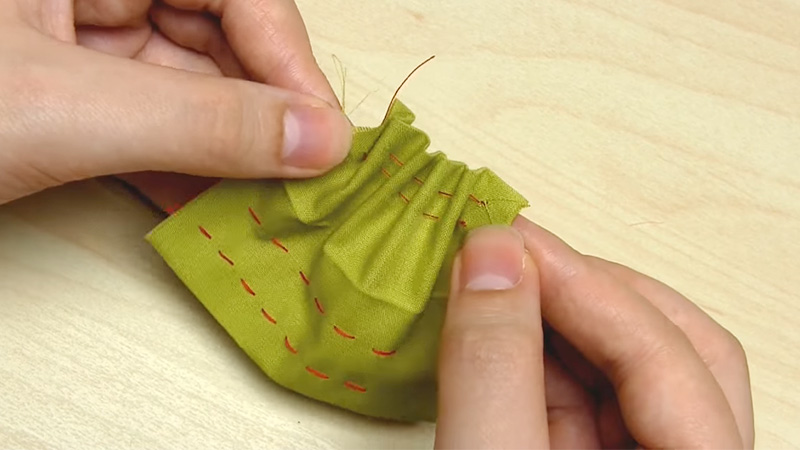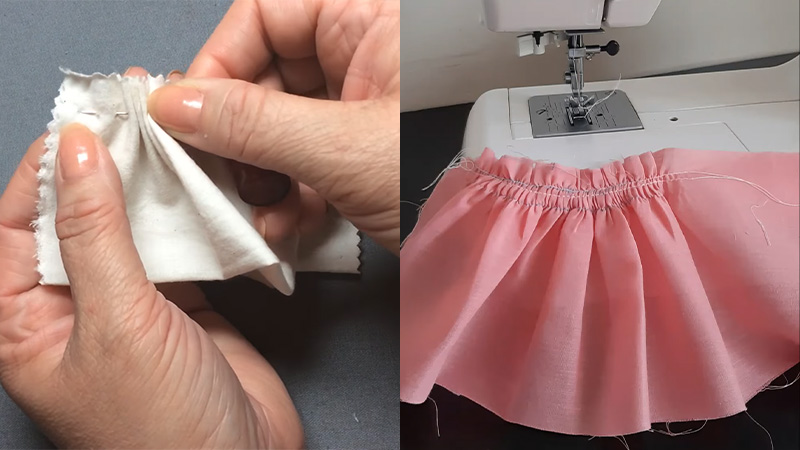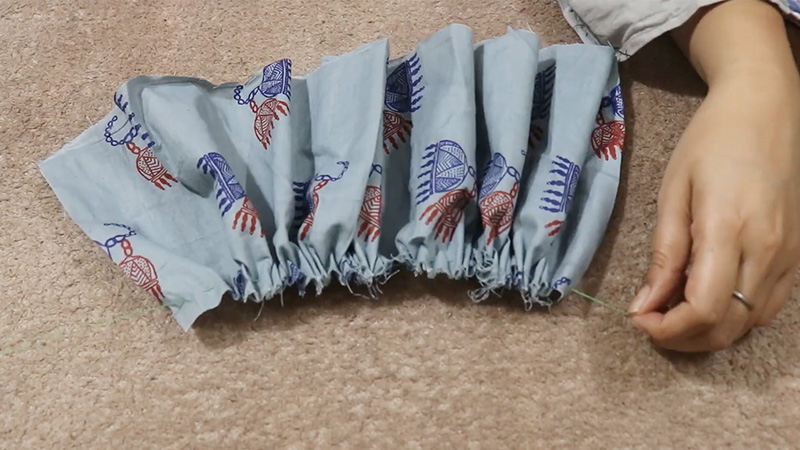In the world of sewing, gathering by hand is a timeless and versatile technique that adds elegance and dimension to your projects.
Whether you’re creating flowing ruffles on a blouse, giving a skirt a romantic flair, or adding a touch of grace to a dress, hand-gathering allows you to exert precise control over your fabric. It’s a skill that every sewing enthusiast should have in their repertoire.
In this comprehensive guide, we will discuss ‘gathering by hand – how to do’. We’ll explore the tools, techniques, and tips needed to create even, delicate gathers that elevate your sewing creations to new heights.
Whether you’re a seasoned seamstress or a novice, this tutorial will equip you with the expertise to use hand-gathering to enhance the beauty and style of your garments.
Prepare to unlock the secrets of this graceful technique as we delve into the art of gathering by hand!

Gathering by Hand: How to Do?
Gathering by hand is a delicate and precise sewing technique that allows you to create even, controlled gathers in your fabric.
This method is often used in various sewing projects to add texture and volume. Here’s a step-by-step guide on how to gather fabric by hand:
Mark the Stitching Line
Choose and prepare the fabric for stitching. Determine where you want to create the gathers on your fabric.
Mark a stitching line along this area using chalk, fabric markers, or pins. Use thread that matches your fabric or a contrasting color for visibility.
Thread Your Needle
Thread your hand-sewing needle with a length of thread (approximately 18 inches long) and tie a knot at the end. You can double the thread for added strength.
Start sewing along the marked stitching line from one end. Use a straight stitch or a running stitch, depending on your preference.
Create Long Basting Stitches
Make long, evenly-spaced stitches along the entire length of the marked line. These stitches will become the gathering stitches, so keep them uniform and about 1/4 to 1/2 inch away from the edge of the fabric.
Leave Thread Tails
Leave a few inches of thread hanging at both ends of the stitching line without knotting them. These thread tails will be used to adjust and secure the gathers later.
Begin Gathering
Hold one end of the fabric and gently push it along the thread while holding the other end stationary. Slide the fabric along the thread to create gathers. Distribute the gathers evenly.
Adjust and Secure
Once you’ve gathered the fabric to your desired fullness, secure the gathers by tying knots at both ends of the gathering stitches. This prevents the gathers from coming undone.
Press the Gathers
Use a cool iron to lightly press the gathered area. Be careful not to flatten the gathers or stretch the fabric while pressing. Trim any excess thread from the knots, leaving a small tail for security.
Finish Your Project
Complete your project as planned, making sure to distribute and secure the gathers as necessary in your design.
Gathering by hand allows you to create elegant, customized gathers that enhance the beauty and style of your sewing projects.
With practice, you’ll become skilled at achieving the desired look and fullness in your gathers, adding a touch of artistry to your creations.
Gathering in Machine Vs. Hand Gathering: Which Is Better?

The choice between machine gathering and hand gathering depends on various factors, including the project’s requirements, your skill level, and personal preferences.
Both methods have their advantages and limitations. Here’s a comparison to help you decide which is better for your specific situation:
Machine Gathering
Pros
Machine gathering is significantly faster than gathering by hand. This is particularly beneficial when working on larger projects or when time is a constraint.
Machines can create consistently even gathers, which can be challenging to achieve by hand, especially for long seams. Machine gathering is relatively straightforward, making it suitable for beginners and those looking for a quicker and more efficient method.
Cons
While machines offer even gathers, they provide less control over the fullness and placement of gathers compared to hand gathering.
Machine gathering may not be suitable for delicate or sheer fabrics, as it can create visible stitching lines that detract from the fabric’s appearance.
Hand Gathering
Pros
Hand gathering allows for precise control over the fullness, spacing, and placement of gathers. This is ideal for intricate or customized designs.
Hand gathering is gentle on delicate fabrics, preventing visible stitching lines and damage to the material.
Hand gathering doesn’t require a sewing machine, making it a portable option for on-the-go sewing.
Cons
Hand gathering is a slower process compared to machine gathering, making it less efficient for larger projects or production sewing.
Achieving consistent and even gathers by hand may require more practice and skill, especially for beginners.
Which Is Better?
If you value precision, customization, and control over your gathers, hand gathering may be the better choice, especially for delicate fabrics and smaller projects.
Machine gathering is advantageous when speed and consistency are priorities, as it’s well-suited for larger projects and when time is limited.
In many cases, a combination of both methods can be effective. For example, you can use machine gathering for long seams and then fine-tune the gathers by hand where more control is needed.
Ultimately, the choice depends on your project’s requirements and your comfort level with each technique.
Variations of Gathering by Hand

Gathering by hand is a versatile sewing technique, and there are several variations you can explore based on your project’s requirements and the effect you want to achieve.
Here are some common variations of gathering by hand:
Basic Hand Gathering
This is the standard method of gathering described earlier, involving long basting stitches and even distribution of gathers. It’s suitable for most gathering needs.
Ruching
Ruching is a variation of hand gathering where you create tighter, more concentrated gathers in a specific area, often used for decorative purposes. This technique adds texture and visual interest to garments.
Gathering with a Drawstring
In this method, you insert a drawstring (like ribbon or cord) along with your gathering stitches.
Once gathered, you can adjust the gathers by pulling the drawstring tight or loosening it. This is useful for creating adjustable waistbands or necklines.
Smocking
Smocking involves creating intricate hand-gathered patterns, typically in a grid or honeycomb design. It’s often used on bodices, cuffs, or yokes for a decorative and textured effect.
Rolled Hem with Gathers
Instead of folding the fabric edge under before gathering, you can create a rolled hem first, and then gather along the rolled edge. This results in a more finished look for gathered hems or ruffles.
Gathering with Elastic Thread
You can use elastic thread in the bobbin of your sewing machine to create shirring, which is a stretchy form of gathering.
When stitched, the fabric gathers on its own. This method works well for creating stretchy cuffs or bodices.
Gathering with a Running Stitch
Instead of the standard straight stitch, you can use a running stitch, which is a simple up-and-down stitch. This creates a more delicate and handmade look for your gathers.
Double Rows of Gathering Stitches
To add extra strength and control to your gathers, you can sew two parallel rows of gathering stitches. This prevents the fabric from slipping or bunching unevenly.
Layered Gathering
In cases where you want multiple layers of gathered fabric, you can gather each layer separately and then attach them together. This is commonly used in tiered skirts or dresses.
Gathering with a Decorative Stitch
Instead of using a basic straight stitch for gathering, experiment with decorative stitches on your sewing machine. This can add unique and eye-catching details to your gathered fabric.
Each of these variations offers distinct visual effects and can be adapted to different sewing projects, from garments to home decor.
Depending on your design and desired outcome, you can choose the gathering technique that best suits your creative vision.
FAQs
When is ruching typically used in sewing projects?
Ruching is often used in sewing projects to add decorative texture and dimension. It’s commonly found on bodices, sleeves, and yokes of dresses and blouses, providing a romantic and feminine touch.
What types of fabrics work best for smocking?
Smocking is often done on lightweight, breathable fabrics such as cotton, voile, or lawn. These fabrics gather well and allow the intricate smocking patterns to shine.
Can I combine different gathering techniques in a single project?
Yes, you can combine various gathering techniques within a single project to achieve different effects.
For instance, you might use standard hand gathering for a skirt and then incorporate smocking on the bodice for a unique design.
What’s the difference between shirring and standard gathering with elastic thread?
Shirring is a specific type of gathering that uses elastic thread in the bobbin. It creates a stretchy, textured effect, often used for fitted cuffs or bodices.
Standard gathering with elastic thread involves inserting elastic within the gathers for added stretch.
Are there any special tips for working with decorative stitches when gathering by hand?
When using decorative stitches for hand gathering, practice on scrap fabric first to ensure you’re satisfied with the result.
Consider adjusting the stitch length and tension to achieve the desired look. Additionally, use thread colors that complement your fabric for a harmonious design.
Conclusion
You’ve now ventured into the enchanting realm of gathering by hand, a skill that brings a touch of sophistication and allure to your sewing projects.
Through this guide, you’ve gained valuable insights into the tools, techniques, and nuances of hand-gathering, setting the stage for your creative journey.
The beauty of hand-gathering lies not only in its elegance but also in the fine control it affords you over your fabric.
With each stitch, you breathe life into delicate ruffles, flowing gathers, and graceful seams that transform your garments from ordinary to extraordinary.
As you continue to practice and perfect this art, remember that patience is your greatest ally. Every gentle tug of the thread, every meticulous fold, and every careful stitch brings you closer to creating the gathers that perfectly complement your vision.
Now, armed with the knowledge and dexterity you’ve acquired, embrace your sewing projects with newfound confidence and grace.
Leave a Reply